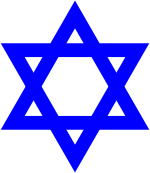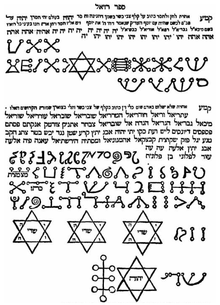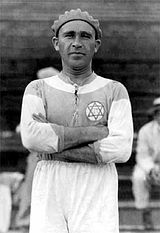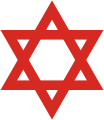- Star of David
-
This article is about the use of the hexagram as a Jewish symbol. For other uses, see Hexagram."Jewish Star" redirects here. For the newspaper, see The Jewish Star.
The Star of David, known in Hebrew as the Shield of David or Magen David (Hebrew מָגֵן דָּוִד; Biblical Hebrew Māḡēn Dāwīḏ, Tiberian [mɔˈɣen dɔˈvið], Modern Hebrew [maˈɡen daˈvid], Ashkenazi Hebrew and Yiddish Mogein Dovid [ˈmɔɡeɪn ˈdɔvid] or Mogen Dovid) is a generally recognized symbol of Jewish identity and Judaism.[1]
Its shape is that of a hexagram, the compound of two equilateral triangles. One triangle represents the ruling tribe of Judah and the other the former ruling tribe of Benjamin. It is also seen as a dalet and yud, the two letters assigned to Judah. There are 12 Vav, or "men," representing the 12 tribes or patriarchs of Israel. The hexagram has been in use as a symbol of Judaism since the 17th century, with precedents in the 14th to 16th centuries in Central Europe, where the Shield of David was partly used in conjunction with the Seal of Solomon (the hexagram) on Jewish flags. Its use probably derives from medieval (11th to 13th century) Jewish protective amulets (segulot).
The term "Shield of David" is also used in the Siddur (Jewish prayer book) as a title of the God of Israel.
Contents
History
The Jewish Encyclopedia cites a 12th-century Karaite document as the earliest Jewish literary source to mention the symbol.[2] Its use as a symbol of the Jewish community dates to the 17th century.
Early use as an ornament
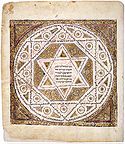 The Star of David in the oldest surviving complete copy of the Masoretic text, the Leningrad Codex, dated 1008.
The Star of David in the oldest surviving complete copy of the Masoretic text, the Leningrad Codex, dated 1008.
The hexagram does appear occasionally in Jewish contexts since antiquity, apparently as a decorative motif. For example, in Israel, there is a stone bearing a hexagram from the arch of a 3rd–4th century synagogue in the Galilee.[3] Originally, the hexagram may have been employed as an architectural ornament on synagogues, as it is, for example, on the cathedrals of Brandenburg and Stendal, and on the Marktkirche at Hanover. A pentagram in this form is found on the ancient synagogue at Tell Hum. In the synagogues, perhaps, it was associated with the mezuzah.
The use of the hexagram in a Jewish context as a possibly meaningful symbol may occur as early as the 11th century, in the decoration of the carpet page of the famous Tanakh manuscript, the Leningrad Codex dated 1008. Similarly, the symbol illuminates a medieval Tanakh manuscript dated 1307 belonging to Rabbi Yosef bar Yehuda ben Marvas from Toledo, Spain. A Siddur dated 1512 from Prague displays a large hexagram on the cover with the phrase, "…He will merit to bestow a bountiful gift on anyone who grasps the Shield of David."[4]
Origin of the name
The name 'Shield of David' was used by at least the 11th century as a title of the God of Israel, independent of the use of the symbol. The phrase occurs independently as a Divine title in the Siddur, the traditional Jewish prayer book, where it poetically refers to the Divine protection of ancient King David and the anticipated restoration of his dynastic house, perhaps based on Psalm 18, which is attributed to David, and in which God is compared to a shield (v. 31 and v. 36). The term occurs at the end of the "Samkhaynu/Gladden us" blessing, which is recited after the reading of the Haftara portion on Saturday and holidays.[5]
The earliest known text related to Judaism which mentions a sign called the "Shield of David" is Eshkol Ha-Kofer by the Karaite Judah Hadassi, in the mid-12th century CE:
Seven names of angels precede the mezuzah: Michael, Gabriel, etc. …Tetragrammaton protect you! And likewise the sign, called the "Shield of David", is placed beside the name of each angel.[6]
This book is of Karaite, and not of Rabbinic Jewish origin, and it does not describe the shape of the sign in any way.
Kabbalistic use
A Shield of David has been noted on a Jewish tombstone in Taranto, Apulia in Southern Italy, which may date as early as the third century CE.[7] [8] The Jews of Apulia were noted for their scholarship in Kabbalah, which has been connected to the use of the Star of David. [9]
Medieval Kabbalistic grimoires show hexagrams among the tables of segulot, but without identifying them as "Shield of David".
In the Renaissance Period, in the 16th-century Land of Israel, the book Ets Khayim conveys the Kabbalah of Ha-Ari (Rabbi Isaac Luria) who arranges the traditional items on the seder plate for Passover into two triangles, where they explicitly correspond to Jewish mystical concepts. The six sfirot of the masculine Zer Anpin correspond to the six items on the seder plate, while the seventh sfira being the feminine Malkhut corresponds to the plate itself.[10][11][12]
However, these seder-plate triangles are parallel, one above the other, and do not actually form a hexagram,.[13]
According to G.S. Oegema (1996)
Isaac Luria provided the Shield of David with a further mystical meaning. In his book Etz Chayim he teaches that the elements of the plate for the Seder evening have to be placed in the order of the hexagram: above the three sefirot "Crown", "Wisdom", and "Insight", below the other seven.[14]
Similarly, M. Costa[year needed][page needed] wrote that M. Gudemann and other researchers in the 1920s claimed that Isaac Luria was influential in turning the Star of David into a national Jewish emblem by teaching that the elements of the plate for the Seder evening have to be placed in the order of the hexagram Gershom Scholem (1990) disagrees with this view, arguing that Isaac Luria talked about parallel triangles one beneath the other and not about the hexagram.[15]
The Star of David at least since the 20th century remains associated with the number seven and thus with the Menorah, and popular accounts[unreliable source?] associate it with he six directions of space plus the center (under the influence of the description of space found in the Sefer Yetsira: Up, Down, East, West, South, North, and Center), or the Six Sefirot of the Male (Zeir Anpin) united with the Seventh Sefirot of the Female (Nukva).[16]
Jewish flags
In 1354, King of Bohemia Charles IV prescribed for the Jews of Prague a red flag with both David's shield and Solomon's seal, while the red flag with which the Jews met King Matthias of Hungary in the 15th century showed two pentagrams with two golden stars.[17]
In 1460, the Jews of Ofen (Budapest, Hungary) received King Matthias Corvinus with a red flag on which were two Shields of David and two stars. In the first Hebrew prayer book, printed in Prague in 1512, a large Shield of David appears on the cover. In the colophon is written: "Each man beneath his flag according to the house of their fathers…and he will merit to bestow a bountiful gift on anyone who grasps the Shield of David." In 1592, Mordechai Maizel was allowed to affix "a flag of King David, similar to that located on the Main Synagogue" on his synagogue in Prague. In 1648, the Jews of Prague were again allowed a flag, in acknowledgment of their part in defending the city against the Swedes. On a red background was a yellow Shield of David, in the center of which was a Swedish star.[18]
As a symbol of Judaism
In the 17th century, the Shield of David as the hexagram began to represent the Jewish community generally, when the Jewish quarter of Vienna was formally distinguished from the rest of the city by a boundary stone having the hexagram on one side and the Christian cross on the other. By the 18th century, the Shield appeared to represent the Jewish people in both secular (politics) and religious (synagogue) contexts. The Star of David can be found on the tombstones of religious Jews in Europe since the 18th century. Following Jewish emancipation after the French revolution, Jewish communities chose the Star of David to represent themselves, comparable to the cross used by most Christians.[citation needed] Then in the 19th century, it began to signify the Jewish people internationally, when the early Zionist movement adopted it as the symbol of the Jewish people, after the Dreyfus affair in France in the 19th century. From here, other Jewish community organizations adopted it too.
The Holocaust
 The yellow badge
The yellow badge
A Star of David, often yellow-colored, was used by the Nazis during the Holocaust as a method of identifying Jews. After the German invasion of Poland in 1939 there were initially different local decrees forcing Jews to wear a distinct sign – in the General Government e.g. a white armband with a blue Star of David on it, in the Warthegau a yellow badge in the form of a Star of David on the left side of the breast and on the back. If a Jew was found without wearing the star in public, they could be subjected to severe punishment. The requirement to wear the Star of David with the word Jude (German for Jew) inscribed was then extended to all Jews over the age of six in the Reich and the Protectorate of Bohemia and Moravia (by a decree issued on September 1, 1941 signed by Reinhard Heydrich [19]) and was gradually introduced in other German-occupied areas.
Modern use
The flag of Israel, depicting a blue Star of David on a white background, between two horizontal blue stripes was adopted on October 28, 1948, five months after the country's establishment. The origins of the flag's design date from the First Zionist Congress in 1897; the flag has subsequently been known as the "flag of Zion".
Contemporary use
Some Orthodox Jewish groups reject the use of the Jewish Star of David because of its association with magic. Neturei Karta and Satmar reject it because they associate it with Zionism.
Many Modern Orthodox synagogues, and many synagogues of other Jewish movements, however, have the Israeli flag with the Star of David prominently displayed at the front of the synagogues near the Ark containing the Torah scrolls.
Magen David Adom (MDA) (Red Star of David or, translated literally, Red Shield of David) is Israel's only official emergency medical, disaster, ambulance service. It is an official member of the International Committee of the Red Cross since June 2006. According to the Israel Ministry of Foreign Affairs, Magen David Adom was boycotted by the International Committee of the Red Cross, which refused to grant the organization membership because "it was…argued that having an emblem used by only one country was contrary to the principles of universality."[20] Other commentators said the ICRC did not recognize the medical and humanitarian use of this Jewish symbol, a Red Shield, alongside the Christian cross and the Muslim crescent.[21]
Athletes
Jewish major league baseball player Gabe Kapler had a Star of David tattooed on his left calf in 2000, with the words "strong-willed" and "strong-minded", major leaguer Mike "SuperJew" Epstein drew a Star of David on his baseball glove, and major leaguer Ron Blomberg had a Star of David emblazoned in the knob of his bat which is on display at the Baseball Hall of Fame.[22][23][24][25][26][27] NBA basketball star Amar'e Stoudemire, who says he is spiritually and culturally Jewish,[28] had a Star of David tattoo put on his left hand in 2010.[29][30] NFL football defensive end Igor Olshansky has Star of David tattoos on each side of his neck, near his shoulders.[31][32][33]
Jewish world light heavyweight world champion boxer Mike "The Jewish Bomber" Rossman fought with a Star of David embroidered on his boxing trunks, and also has a blue Star of David tattoo on the outside of his right calf.[34][35][36][37] World heavyweight boxing champion Max Baer fought with a Star of David on his trunks as well, notably, for the first time as he knocked out Nazi Germany hero Max Schmeling in 1933; Hitler never permitted Scmheling to fight a Jew again. Other boxers who fought with Stars of David embroidered on their trunks to reflect their ethno-religious pride included world lightweight champion Benny "the Ghetto Wizard" Leonard (who said he felt as though he was fighting for all Jews), world light heavyweight boxing champion Battling Levinsky, Barney Ross (world champion as a lightweight, as a junior welterweight, and as a welterweight), world flyweight boxing champion Victor "Young" Peres ("Young"), and more recently World Boxing Association super welterweight champion Yuri Foreman and light middleweight Boyd Melson.[38][34][39][40][41][42][43] Welterweight Dmitriy Salita even boxes under the nickname "Star of David".[44]
Teams
Hakoah Vienna was a Jewish sports club founded in Vienna, Austria, in 1909 whose teams competed with the Star of David on the chest of their uniforms, and won the 1925 Austrian League soccer championship.[45] Similarly, The Philadelphia Sphas basketball team in Philadelphia (whose name was an acronym of its founding South Philadelphia Hebrew Association) wore a large Star of David on their jerseys to proudly proclaim their Jewish identity, as they competed in the first half of the 20th century.[46][47][48][49] Maccabi clubs still use the Star of David in their emblems.[50]
Miscellaneous
- In Unicode, the "Star of David" symbol is U+2721 (✡).
- The world's largest Star of David (167 metres (548 ft) diameter) is in the Smoky Hill Weapons Range, Kansas, USA at 38°43′04″N 97°48′24″W / 38.717704°N 97.80673°W.
- At London Heathrow Airport in the early 1950's were built six runways in ✡ layout, each a bit over a mile long.
Gallery
-
The Magen David Adom emblem
-
A recruitment poster published in American Jewish magazines during WWI. Daughter of Zion (representing the Jewish people): Your Old New Land must have you! Join the Jewish regiment.
See also
- Anahata
- Chai symbol
- G2 (mathematics)
- Merkaba
- Shatkona, an identical Hindu symbol.
- Star of Bethlehem
- Star of David theorem
- Star of Lakshmi
- Unicursal hexagram
References
- ^ Judaism A-Z Yacov Newman, Gavriel Sivan
- ^ "Magen Dawid", Jewish Encyclopida [1], retrieved 2010 May 28.
- ^ "King Solomon's Seal", MFA, King Solomon-s Seal.
- ^ Ulmann.
- ^ A similar term, "Shield of Abraham" appears in the first blessing of the "Amidah" prayer, which was written in early Rabbinic times (around year 1, a millennium before the first documentation of the term in reference to a six-point star). That term is probably based on Genesis 15:1, where God promises to shield Abraham.
- ^ Eshkol Ha-Kofer by Judah Hadassi, 12th century CE
- ^ Herbert M. Adler, JQR, vol. 14:111. Cited in "Magen David", Jewish Encyclopedia [2], retrieved 2010, May 28.
- ^ [http://www.holidayinisrael.com/ViewPage.asp?lid=1&pid=338
- ^ www.markfoster.net
- ^ Rabbi Blumenkrantz, "The Seder", The Laws of Pesach: A Digest 2010: Chap. 9. See also, [3], retrieved 2010 May 28.
- ^ "Magen David", Ask the Rabbi [4], retrieved 2010, May 28.
- ^ Simon Jacobson, op. ed., "Tzav-Passover: The Seder Plate", A Meaningful Life, [5], retrieved 2010 May 28.
- ^ Gershom Scholem shows conclusively they do not form a hexagram. See, Hatakh ha-Zahav, Hotam Shelomoh u-Magen-David (Poalim, Hebrew) 1990:156.
- ^ G.S. Oegema, Realms of Judaism. The history of the Shield of David, the birth of a symbol (Peter Lang, Germany, 1996) ISBN 3-631-30192-8
- ^ Hatakh ha-Zahav, Hotam Shelomoh u-Magen-David (Poalim, 1990, Hebrew) p.156
- ^ What is the Mystical Significance of the Star of David? By Rabbi Naftali Silberberg
- ^ Schwandtner, Scriptores Rerum Hungaricarum, ii. 148. Facsimile in M. Friedmann, Seder Eliyahu Rabbah ve-Seder Eliyahu Ztṭa, Vienna, 1901
- ^ The National Flag at MFA
- ^ Polizeiverordnung über die Kennzeichnung der Juden (came into force September 19, 1941)
- ^ Geneva Vote Paves the Way for MDA Red Cross Membership, Israel Ministry of Foreign Affairs, 8-Dec-2005 [6]
- ^ Magen David: Shield or Star? On Language, by Philologos, The Jewish Daily Forward June 30, 2006 [7]
- ^ Paul Lukas (April 2, 2007). "Uni Watch: Passover edition – Page 2". ESPN. http://sports.espn.go.com/espn/page2/story?page=lukas/070402. Retrieved February 17, 2011.
- ^ "Sox pair weigh holiday play; councilor swept up". The Boston Globe. September 24, 2004. http://www.boston.com/ae/celebrity/articles/2004/09/24/sox_pair_weigh_holiday_play_councilor_swept_up/. Retrieved February 17, 2011.
- ^ "Jewish Stars". Cleveland Jewish News. April 16, 2010. http://www.clevelandjewishnews.com/articles/2010/04/16/arts/jewish_stars/doc4bc77d3bbc236279484076.txt. Retrieved February 17, 2011.
- ^ Ain, Stewart (September 8, 2006). "Fast Balls Keep Flying At Mel". The Jewish Week. http://www.thejewishweek.com/features/fast_balls_keep_flying_mel. Retrieved February 17, 2011.
- ^ "It started as a great idea, then fate stepped in". Jewish Tribune. September 29, 2005. http://www.jewishtribune.ca/tribune/jt-050929-21.html. Retrieved February 17, 2011.
- ^ Salkin, Allen. "Where have you gone, Sandy Koufax?". Charlotte.creativeloafing.com. http://charlotte.creativeloafing.com/gyrobase/Content?oid=oid%3A4463. Retrieved February 17, 2011.
- ^ "Amar’e Stoudemire’s Quest to Israel", The New York Times, August 3, 2010
- ^ "Is Amare Stoudemire Jewish? Knick Shows Star Of David Tattoo, Wears Yarmulke (VIDEO)". Huffington Post. http://www.huffingtonpost.com/2010/08/02/is-amare-stoudemire-jewis_n_667712.html. Retrieved February 17, 2011.
- ^ "Knicks star Amar'e Stoudemire keeps things kosher". The New York Post. August 20, 2010. http://www.nypost.com/p/pagesix/amar_keeps_things_kosher_nN6oBep1HNbfqp0JXVPmFP. Retrieved February 17, 2011.
- ^ "Are you ready for some football? » Kaplan’s Korner on Jews and Sports". New Jersey Jewish News. September 14, 2009. http://njjewishnews.com/kaplanskorner/2009/09/14/are-you-ready-for-some-football/. Retrieved February 17, 2011.
- ^ Whisler, John (August 1, 2009). "Cowboys add muscle on defense with Olshanksy". Houston Chronicle. http://www.chron.com/disp/story.mpl/sports/6557606.html. Retrieved February 17, 2011.
- ^ "Tenacious D – by Nisha Gopalan". Tablet Magazine. November 14, 2008. http://www.tabletmag.com/news-and-politics/3322/tenacious-d/. Retrieved February 17, 2011.
- ^ a b The Big Book of Jewish Sports Heros: An Illustrated Compendium of Sports History and The 150 Greatest Jewish Sports Stars. SP Books. 2007. http://books.google.com/books?id=dDyEVDIA3aIC&pg=PA265&dq=%22star+of+david%22+baseball+-tattoo&hl=en&ei=2G5cTdzYBoKglAfFoYTkCQ&sa=X&oi=book_result&ct=result&resnum=8&ved=0CFgQ6AEwBw#v=onepage&q=%22star%20of%20david%22&f=false. Retrieved February 17, 2011.
- ^ "Dodger-Giant Rivalry Downright Nostalgic", The Spokesman-Review, September 24, 1978
- ^ Volume 39. 2006. http://books.google.com/books?id=KpkpAQAAIAAJ&q=tattoo+%22star+of+david%22+boxer&dq=tattoo+%22star+of+david%22+boxer&hl=en&ei=52pcTbHAKcKclgfl1LTkCQ&sa=X&oi=book_result&ct=result&resnum=2&ved=0CD8Q6AEwAQ. Retrieved February 17, 2011.
- ^ Pat Putnam (December 18, 1978). "Mom is Jewish, Dad is Italian, and Mike Rossman—the Star". Sports Illustrated. http://sportsillustrated.cnn.com/vault/article/magazine/MAG1094435/3/index.htm. Retrieved February 17, 2011.
- ^ The 1930s. Weigl Educational Publishers. 2000. http://books.google.com/books?id=0bTIwIJmOiUC&pg=PA28&dq=%22star+of+david%22+baseball+-tattoo&hl=en&ei=F3JcTe3WBcGclgehwITnCQ&sa=X&oi=book_result&ct=result&resnum=5&ved=0CEMQ6AEwBDge#v=onepage&q=%22star%20of%20david%22%20baseball%20-tattoo&f=false. Retrieved February 17, 2011.
- ^ Triumph: the untold story of Jesse Owens and Hitler's Olympics. 2007. http://books.google.com/books?id=DSsdGalGcPMC&pg=PA85&dq=skater+%22star+of+david%22&hl=en&ei=CG5cTYP5MYGglAfDutzuCQ&sa=X&oi=book_result&ct=result&resnum=9&ved=0CFYQ6AEwCA#v=onepage&q=skater%20%22star%20of%20david%22&f=false. Retrieved February 17, 2011.
- ^ Ellis Island to Ebbets Field: Sport and the American Jewish Experience. Oxford University Press. 1993. http://books.google.com/books?id=qjOYf1YAhaoC&pg=PA120&dq=%22star+of+david%22+baseball+-tattoo&hl=en&ei=2G5cTdzYBoKglAfFoYTkCQ&sa=X&oi=book_result&ct=result&resnum=6&ved=0CE8Q6AEwBQ#v=onepage&q=%22star%20of%20david%22&f=false. Retrieved February 17, 2011.
- ^ "Realism for the masses: aesthetics, popular front pluralism, and U.S. culture, 1935–1947". 2009. http://books.google.com/books?id=oNKyvL7ccB4C&pg=PA7&dq=%22star+of+david%22+baseball+-tattoo&hl=en&ei=F3JcTe3WBcGclgehwITnCQ&sa=X&oi=book_result&ct=result&resnum=1&ved=0CDAQ6AEwADge#v=onepage&q=%22star%20of%20david%22&f=false. Retrieved February 17, 2011.
- ^ Sport in America eBook, Volume II. http://books.google.com/books?id=LwdEP9ISuCEC&pg=PA295&dq=%22star+of+david%22+baseball+-tattoo&hl=en&ei=F3JcTe3WBcGclgehwITnCQ&sa=X&oi=book_result&ct=result&resnum=10&ved=0CF4Q6AEwCTge#v=onepage&q=%22star%20of%20david%22%20baseball%20-tattoo&f=false. Retrieved February 17, 2011.
- ^ A Voice Called: Stories of Jewish Heroism. 2010. http://books.google.com/books?id=gKSLDHiWlZoC&pg=PA75&dq=%22star+of+david%22+boxer&hl=en&ei=xlBfTdWSCIiFtgfb4ZTlCw&sa=X&oi=book_result&ct=result&resnum=3&ved=0CDgQ6AEwAjgU#v=onepage&q=%22star%20of%20david%22%20boxer&f=false. Retrieved February 19, 2011.
- ^ Isaac Barrio (July 19, 2006). "Dmitriy “STAR OF DAVID” Salita in Main Event". Hardcoreboxing.net. http://www.hardcoreboxing.net/SALITA7192006.htm. Retrieved February 17, 2011.
- ^ Emancipation through muscles: Jews and sports in Europe. 2006. http://books.google.com/books?id=Iye9CDk0X_IC&pg=PA252&dq=%22star+of+david%22+baseball+-tattoo&hl=en&ei=Y3ZcTYC7OYKclgf3w7DkCQ&sa=X&oi=book_result&ct=result&resnum=2&ved=0CCsQ6AEwAThQ#v=onepage&q=%22star%20of%20david%22%20&f=false. Retrieved February 17, 2011.
- ^ Encyclopedia of American Jewish history. ABC-CLIO,. 2007. http://books.google.com/books?id=QV8YAQAAIAAJ&q=%22star+of+david%22+basketball+-tattoo&dq=%22star+of+david%22+basketball+-tattoo&hl=en&ei=BX9cTfWHMoPGlQfZmrDlCQ&sa=X&oi=book_result&ct=result&resnum=1&ved=0CDMQ6AEwAA. Retrieved February 17, 2011.
- ^ Outside the box: a memoir. Rodale. 2006. http://books.google.com/books?id=HuzYfr7aM5wC&pg=PA11&dq=%22star+of+david%22+basketball+-tattoo&hl=en&ei=BX9cTfWHMoPGlQfZmrDlCQ&sa=X&oi=book_result&ct=result&resnum=4&ved=0CEEQ6AEwAw#v=onepage&q=%22star%20of%20david%22%20basketball%20-tattoo&f=false. Retrieved February 17, 2011.
- ^ Philadelphia Jewish life, 1940–2000. Temple University Press. 2006. http://books.google.com/books?id=5zOJ_aZIcooC&pg=PA193&dq=%22star+of+david%22+hockey+-tattoo&hl=en&ei=QoJcTYTqD4L6lwfyp8zkCQ&sa=X&oi=book_result&ct=result&resnum=3&ved=0CDgQ6AEwAg#v=onepage&q=%22star%20of%20david%22%20hockey%20-tattoo&f=false. Retrieved February 17, 2011.
- ^ Encyclopedia of ethnicity and sports in the United States. 2000. http://books.google.com/books?id=xdV_JV1fbZMC&pg=PA360&dq=team+%22star+of+david%22&hl=en&ei=71leTaLHB5OUtwe-mu38Cw&sa=X&oi=book_result&ct=result&resnum=3&ved=0CDoQ6AEwAjgK#v=onepage&q=team%20%22star%20of%20david%22&f=false. Retrieved February 19, 2011.
- ^ Football: a sociology of the global game. Wiley-Blackwell. 1999. http://books.google.com/books?id=dO1vJEAv1KQC&pg=PA12&dq=%22star+of+david%22+football+-tattoo&hl=en&ei=7XpcTY3JH4GKlwfzzNTlCQ&sa=X&oi=book_result&ct=result&resnum=1&ved=0CCsQ6AEwAA#v=onepage&q=%22star%20of%20david%22%20football%20-tattoo&f=false. Retrieved February 17, 2011.
External links
Categories:- Star symbols
- Jewish symbols
- David
Wikimedia Foundation. 2010.

